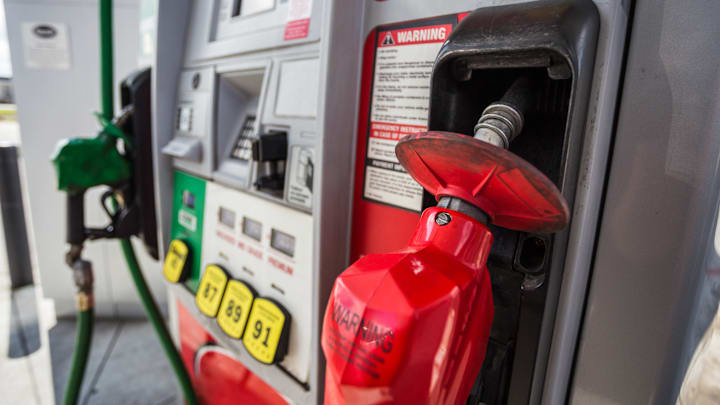While people are often struck by Starbucks storefronts being mere blocks from each other, the real mystery in consumerism is the gas station. Drive down a town’s main artery and you’re likely to see competing pumps located just hundreds of feet apart or even positioned across the street from one another. Don’t these businesses cannibalize each other? Why wouldn’t they choose another area where they can monopolize sales?
A concentration of gas stations (or other businesses) is called clustering, and there’s some economic theory on why it’s actually beneficial.
Hotelling’s Law
Presh Talwalkar, author of The Joy of Game Theory: An Introduction to Strategic Thinking, offers one of the more concise explanations of store clustering. Talwalkar cites Hotelling’s Law, an economic premise devised by economist Harold Hotelling. The theory states that when competitors are vying for customers, they’ll naturally flock to a common middle ground.
Imagine, as Talwalkar does, hot dog vendors setting up their wares on a beach. At first glance, it might make sense for a vendor to position themselves as far from their business rival as possible to serve beachgoers who won’t want to make the trek to the other location. Call them the left side stand. Business is good, but a vendor will soon realize it would be better to move closer to the middle to vie for customers in that area. They won’t lose existing patrons and only stand to gain.

The right side stand has (or will quickly assume) the same idea. The result is two hot dog stands in relatively close proximity to one another. They’ve achieved a kind of equilibrium, one in which a vendor starting out appeasing beachgoers further off-center will eventually migrate to the middle, with the other quickly following suit.
The same principle applies to storefronts of all kinds, with “the beach” standing in for various kinds of prime real estate. When it comes to gas stations, operators want to be near high-traffic areas, or wherever they feel demand will be highest. That means a main street, possibly near a highway off-ramp or a popular tourist spot. In any case, the station has no incentive to deviate from a prime location, even if it means being in a congested area of competition. Moving a gas station five blocks away could mean losing business to patrons who have no incentive to seek them out.
But suppose the gas station did succeed outside the cluster, becoming highly profitable. That monopoly wouldn’t last because other stations would recognize their success and quickly branch out, creating a new cluster of competition.
Many businesses look at similar data: foot traffic, construction costs, and population density all help determine desirable real estate. It’s why you’re likely to see a McDonald’s, Wendy’s, and Burger King all within walking distance of the other; it’s also why you’ve probably seen a row of bars near a college. Competing in a centralized location is better than not competing at all by moving out of the cluster.
Standing Out
So if three gas stations are all within sight of a driver, how do they stand out? One obvious ploy is in gas pricing, though once again equilibrium tends to win out here. If one station undercuts another, the rival station will have to quickly adjust pricing to remain competitive, thus canceling the advantage.

Stations may use other incentives. On a warm day, that could mean rolling out coolers full of cold drinks. Others might share a building with a popular coffee or fast food chain. Some may even use their own branding. Buc-ee’s, for example, has become a cultural touchstone thanks to its reputation for convenience store food and spotless bathrooms.
There is one adverse consequence of gas station clustering: health issues. A paper published in the Journal of Environmental Health Science & Engineering in 2021 argued that there might be an increased risk of cancer for those living near multiple stations due to the increased volume of benzene and other toxic emissions. Sound economic theory? Sure. Sound health practice? Maybe not.
Get More Facts About Gas Stations:
